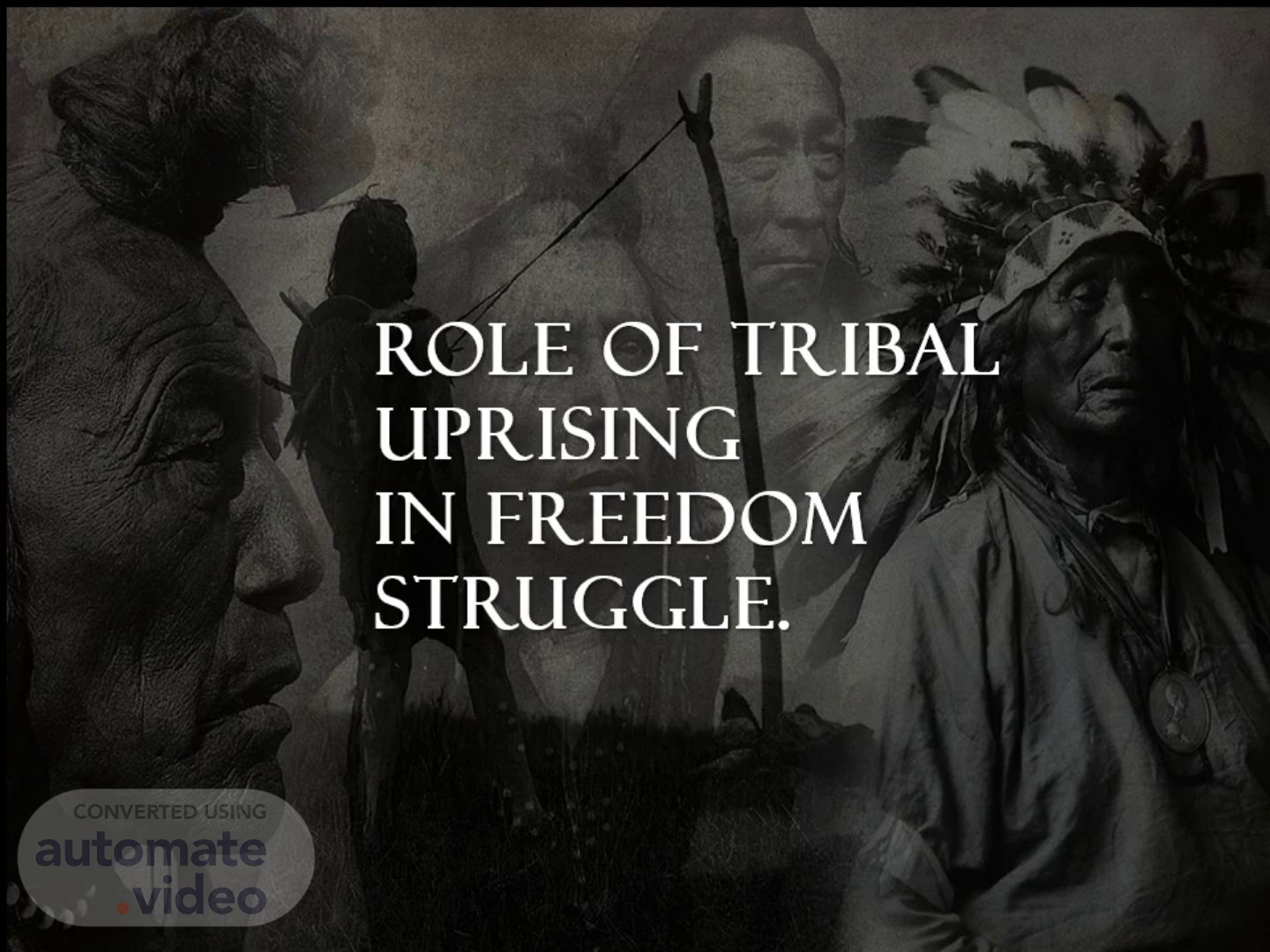Scene 1 (0s)
An image depicting the role of tribal uprisings in India's freedom struggle. The scene shows a group of tribal warriors armed with traditional weapons, like bows and arrows, standing in a defiant posture in front of British colonial soldiers. The tribal fighters are shown in their natural surroundings, such as dense forests and hilly terrain, wearing traditional clothing and war paint. The colonial soldiers are depicted with muskets and the Union Jack flag in the background, symbolizing the British rule. There is a sense of resistance, courage, and unity among the tribals as they confront their oppressors, representing their significant role in India's fight for independence..
Scene 2 (1s)
Who are tribal people ?. Tribal people are indigenous communities with distinct cultures and traditions..
Scene 3 (4s)
Impact of Tribal Uprisings on India’s Freedom Movement :-.
Scene 4 (10s)
Impact of Tribal Uprisings on India’s Freedom Movement: -.
Scene 5 (16s)
Some famous tribal leader:-. Veer Surendra Sai Sidhu Kanhu Murmu Tantya Bhil.
Scene 6 (21s)
Veer Surendra Sai Led the rebellion against British colonial rule in the 1850s, focusing on local grievances. Advocated for the rights of tribal people, particularly concerning land and resources. Inspired local communities to resist colonial oppression and unite for their rights..
Scene 7 (27s)
SIDHU Sidhu Led The Santhal Rebellion, Contributing To The Larger Freedom Struggle Against British Rule. His Leadership And Bravery Inspired Other Tribal Leaders And Communities To Join The Independence Movement. His Actions Contributed To The Awakening Of Nationalist Sentiments Among Various Communities Across India..
Scene 8 (33s)
Kanhu Murmu Kanhu Murmu Was A Key Leader Alongside His Brother Sidhu In The Santhal Rebellion (1855-56). He United The Santhal Community Against British Oppression And Exploitation By Zamindars. Captured By British Forces, Kanhu Was Executed, Solidifying His Status As A Martyr For Tribal Rights..
Scene 9 (38s)
TANTYA BHIL Tantya Bhil Was A Prominent Leader Of The Bhil Tribal Community In Madhya Pradesh. Led Uprisings Against British Colonial Rule In The Late 19th Century. Fought For The Rights Of The Bhil People Against Oppressive Landlords And British Policies Emphasized The Importance Of Bhil Culture And Identity In The Context Of Colonial Oppression..
Scene 10 (44s)
Birsa Munda Birsa Munda Was A Prominent Tribal Leader In Jharkhand, Belonging To The Munda Community. Played A Significant Role In The Santhal Rebellion Of 1855-56 Against British Colonial Rule. Led The Ulgulan (Great Rebellion) Movement In The Late 19th Century Against Land Alienation And British Oppression..
Scene 11 (50s)
Alluri Sitarama Raju Alluri Sitarama Raju Led The Rampa Rebellion (1922-1924) Against British Rule In The Eastern Ghats Of India. Utilized Guerrilla Warfare Strategies To Resist British Forces, Gaining Significant Support From Local Tribes. Fought For The Rights Of Tribal Communities, Addressing Issues Like Land Alienation And Exploitation. Captured By British Forces And Executed In 1924.
Scene 12 (56s)
Komaram Bheem Komaram Bheem Was A Prominent Leader Of The Gond Tribal Community In Telangana. Advocated For The Establishment Of Gond Raj (Gond Kingdom) To Ensure Self-rule For The Tribal Community. Led The Gundar Gutta Movement In The 1940s, Demanding Justice For Tribal People..
Scene 13 (1m 2s)
Rani Gaidinliu Rani Gaidinliu Was A Prominent Naga Leader And Freedom Fighter From Manipur. A Spiritual Leader Advocating For The Revival Of Traditional Naga Culture And Beliefs. Played A Crucial Role In The Zeliangrong Movement, Promoting Unity Among Different Naga Tribes..
Scene 14 (1m 8s)
CONCLUSION Tribal uprisings played an integral role in shaping India’s independence. They highlighted injustices faced by marginalized communities. Influential tribal leaders emerged, inspiring unity and action. These movements emphasized the preservation of indigenous cultures. They influenced policy changes regarding land and governance..
Scene 15 (1m 12s)
Thank you for supporting the She Grows appeal. An image depicting the role of tribal uprisings in India's freedom struggle. The scene shows a group of tribal warriors armed with traditional weapons, like bows and arrows, standing in a defiant posture in front of British colonial soldiers. The tribal fighters are shown in their natural surroundings, such as dense forests and hilly terrain, wearing traditional clothing and war paint. The colonial soldiers are depicted with muskets and the Union Jack flag in the background, symbolizing the British rule. There is a sense of resistance, courage, and unity among the tribals as they confront their oppressors, representing their significant role in India's fight for independence..
